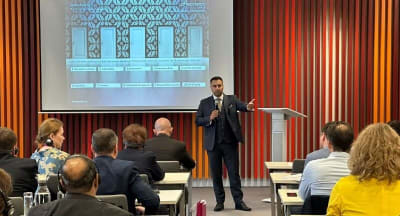Jul 10, 2020
COVID-19: Which jobs aren’t coming back after the pandemic?

While market leaders and major key players of the global economy, including Apple, Microsoft and Facebook, have urged their staff to work from home during the coronavirus pandemic, and in some cases – like Google, Twitter and Square – indefinitely, the majority of the global economy is not location-dependent and is taking a hit.
According to the Economics professor at Stanford University, Nicholas Bloom, 60% of the employment reduction caused by COVID-19 is expected to be temporary, whereas 40% is going to be permanent. Coronavirus is permanently changing the job market, from wiping out millions of jobs worldwide, to creating jobs that never existed before the pandemic. Now, for every 10 jobs lost, 3 are being created – while Nordstrom, Macy’s, Bloomingdale’s, Saks Fifth Avenue and Neiman Marcus are closing multiple locations, the likes of Walmart and Amazon are hiring in thousands, the latter – reportedly creating 175,000 new jobs during the lockdown. In sectors which are currently doing well, e.g. essential retail, banking and finance, telecommunications, customer service, public health and government, healthcare & pharmaceuticals, technology & IT, and news & publishing, new occupations are coming up – contact tracers, COVID-19 testers, COVID-19 caregivers, temperature screeners, facemask sewers, screen manufacturers and installers, and Zoom support specialists. But what will happen with the 10 jobs lost?
While some roles can morph, for example – from a security guard to a temperature checker, others will be crushed. According to The Harris Poll research, it will take us 4-6 months to get back to flying on a plane and staying at a hotel, and at least a year to consider taking a cruise. Financially, this means that the estimated 4.72B passengers worldwide in 2020 would have generated an estimated revenue of $581B in the air passenger traffic, hence, leaving behind an estimated revenue loss of airlines amounting $314B. Global travel and tourism market is predicted to see a loss of 100.8 million jobs worldwide in 2020, with the biggest loss from COVID-19 in the Asia Pacific region, losing approximately 63.4 million jobs. International Labour Organization is expecting a loss of 12 million full-time jobs in accommodation and food services, manufacturing, retail and administration in Europe in 2020, whereas the US Bureau of Labor Statistics reports that their current overall real unemployment rate is closer to 20% rather than previously reported 14.7%.
Historically, every recession is likely to induce a spike in the automation of labor – crisis have the greatest impact on the easily-automatable jobs, resulting with permanent changes in operations on a large scale. The First Industrial Revolution, 1760 – 1840, produced unprecedented prosperity and wealth, however the immediate impact of mechanization was devastating on the majority of population. During the last recession in 2008, we’ve seen the automatization of the routine jobs, especially in the auto and manufacturing sector. Artificial intelligence (AI) systems of the Technological Revolution, introduced as the Fourth Industrial Revolution by the World Economic Forum for the first time in 2015 in Davos-Kloster in Switzerland, have the same potential to transform our society for the better, conditioned by the short-term management of our transition. The coronavirus global recession is imminent – while Cyprus’ economy is expected shrink by 7.7% this year, less than the 8.7% originally forecast, World Bank is forecasting that the global economy will shrink by 5.2% this year.
We already utilize robotics and AI in retail, healthcare, bomb-disposal, driverless cars, cashierless checkouts, warehouse sorting, shipping and packaging – from disinfecting and sanitizing surfaces, walking dogs, delivery of supplies and autonomous floor cleaning & care, robots inhabit most of the aspects of our everyday life and will affect every industry in the near future, starting with:
- PayPal have activated chatbots, using them for 65% of message-based customer inquiries in the last couple of weeks.
- McDonalds have been testing robots as cooks and servers.
- South Korean healthcare is using robots to measure temperature and distribute hand sanitizers.
- UiPath is working on software robots for rapid COVID-19 testing results.
- IPsoft is developing an AI Amelia to answer service requests for banks, IT desks and, most recently, to screen AskMD platform requests for COVID-19 symptoms.
- AMP Robotics are supporting the recycling industry with the robots sorting out used plastic and paper.
- Ford Motor’s delivery van prototype includes a robot dispatching a package from the vehicle to a door, targeting a multi-billion dollar market.
- UVD Robots are shipping their ultraviolet-light-disinfection robots to Europe and China.
- Facebook and Google utilize AI to remove inappropriate posts, and YouTube is using automated systems for content moderation.
- Currently, 26 operational Amazon Go stores, powered by self-driving cars technology, offer Just Walk Out Shopping – come in, take what you want and just walk out, without lines or checkout, completing the purchase via Amazon Go app without any actions required from the shoppers’ side.
As futuristic as it sounds, emerging technologies will continue to bring the end to many familiar practices – after all, renting a DVD was a part of our daily routine just over 15 years ago, while Blockbuster Video stores produced massive profits in the ‘80s and ‘90s with close to 20 million active members and company shares trading for nearly $30 at the time. Change is inevitable, and, once a David to their Goliath, Netflix took over in strides by embracing the evolution of streaming video services, resulting with immense growth of up to 158 million paid memberships in over 190 countries.
Routine jobs in predictable environments, as operating machinery, preparing fast food or collecting data, as well as the middle management occupations, like bookkeeping, back-office transactions processing, software development and financial analysis, are most susceptible to further automation. According to the US Bureau of Labor Statistics’ occupational projection data, 37 jobs are expected to have significantly lower rates of employment by 2028, including locomotive firers, parking enforcement workers, word processors and typists, legal secretaries, data entry keyers, telephone operators, etc.
Businesses are facing a choice globally – returning to an improved version of yesterday, or creating a sustainable plan for the future. The pandemic has brought attention to the impact of technology in telemedicine, biotech, manufacturing, education, food production and delivery, and many more – Robotic Process Automation (RPA), already on the rise long before the pandemic, is enabling businesses to program a software mimicking human workers online, opening the economy to automation at a time when the majority of businesses have been forced to turn to remote working.
And, while the coronavirus-accelerated evolution of the demand in staffing is expected to cause significant turbulence in the labour market, we believe in embracing the progress, rather than fearing it. AI cannot replace human creativity, innovation or empathy – the purpose is to augment human-employee productivity by having robots perform repetitive and routine work, while workers can focus on other, unpredictable tasks. Further, for each business adopting robotic systems, three new human jobs will follow – someone to install, to operate and to maintain. Hence, instead of being regarded as a personnel replacement, AI ascension can be best utilized for bridging the gap between what we, as humans can accomplish and what is actually possible with the implementation of the ‘hybrid workforce’.
Jelena Sucevic
Client Relationship Executive with FinExpertiza Cyprus








